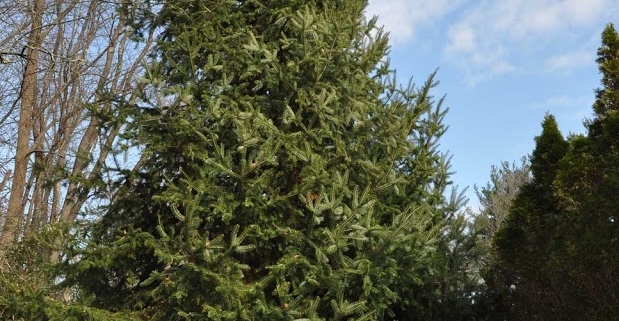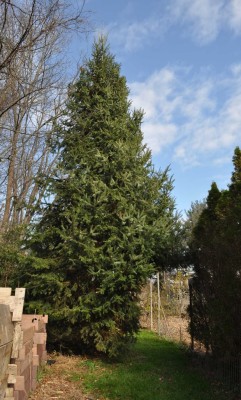XMAS TREE PLANTATION ON MINI-PLOT
A living Christmas tree seems the “right” thing to do: You get a holiday tree decorating your living room for a couple weeks; the planet gets a tree to soak up carbon dioxide, provide a playground for wildlife, and contribute to the landscape greenery. The problem is that yearly planting out of living Christmas trees in most yards pretty soon leads to a small-scale version of the Black Forest. A lugubrious and mysterious landscape is not for everyone.
But there is a way to enjoy living Christmas trees, and keep the scene sunny and winsome: Plant very young trees, then harvest them when they reach the size to cut for Christmas. Essentially, have your own tree farm. The tree lives — and you enjoy it as such — until you cut it.
You may imagine that a tree farm big enough to supply you with one tree a year would take up too much space. Not so. A Christmas tree needs about eight years to grow to a harvestable size of about six feet tall. If you have enough space for eight trees, you can cut one and plant a new one every year, for an endless supply. At five foot spacing, all you need is about 200 square feet of area — perhaps a forty foot row, perhaps a rectangular plot ten by twenty feet. This spacing gives each plant enough sun to grow into a well-shaped tree, and allows you plenty of room to mow around each tree. If you prefer smaller Christmas trees, you can plant even closer.
Your tree farm need not be in an out-of-the-way place. A row of trees might make a nice, evergreen hedge. With the wide spacing and variation in tree sizes, the hedge will be somewhat informal. But at least you do not have to worry about the hedge becoming too tall, because trees get removed as soon as they are about head height. The trees also might make a nice screen for your compost bin or dog’s house. How about a miniature forest for your child?
Growing your own trees gives you the option of choosing whatever type of Christmas tree you want. Most commonly cut nowadays for Christmas trees is Scotch pine, a tree that is very cold-hardy, fast growing, and tolerant of many different soil types. And, the plant holds its needles very well indoors.
———————————————-
Scotch pine has been popular only since the 1930s, and over the years many other species have been in favor. In the middle of the 19th century, cedar was a favorite. But it dropped its needles too easily indoors. Then hemlock, one of the fastest growing evergreens, became popular. Its main defect is that its flexible branches bow too far to the ground under the weight of ornaments. Nowadays it’s also beset by a serious insect pest, the woolly adelgid. By the end of the 19th century, balsam fir became popular. This tree, still popular for Christmas in New England, makes up for its deficiencies — slow growth, less than ideal shape, and some needle drop — with its woodsy aroma that is rightly reminiscent of northern or mountaintop forests.
If you grow balsam fir — and I planted a half-dozen of them almost 20 years ago — make sure to give it a cool, moist soil. The climate around here is warmer than usually enjoyed by balsam fir, but I figured that the fragrance made balsam fir worth a try. My dog Stick, then a leashed puppy, soon chewed up 5 of my young trees, which were all that he could reach when he was young and leashed. One survived, and the survivor is now a towering, fragrant beauty about 25 feet tall and so wide that I had to cut an opening in its lower limbs to allow passage past it along the back portion of the garden.
I never could bring myself to cut that sole survivor to bring indoors for the holidays. The tree is so kind as to keep making two leading stems. Cutting one of them lets the other grow and gives me a manageable holiday tree that leaves the remaining tree healthier. If both leading stems were allowed to grow, they would be apt to split apart at their origin.
———————————————————–
Nowadays, besides Scotch pine, other popular Christmas trees include eastern white pine, Norway spruce, white and Colorado spruces, Douglas fir, and Fraser fir. White pine is fast growing, with an open form that you may or may not prefer in a Christmas tree. This native plant tolerates almost any soil, and even a bit of shade. Norway spruce is almost as fast growing, and is a graceful tree with arching limbs along the bottoms of which dangle short, needled branchlets. Norway spruce needs well-drained soil and full sun.
White and Colorado spruce, and Douglas and Fraser firs, are slow-growing trees. (The two firs are unrelated: Douglas is Pseudotsuga menziesii; Fraser is Abies fraserii.) The two spruces require moist, yet well-drained soil, in full sun. Douglas fir needs full sunlight, but cannot tolerate a windy site or dry soil. Douglas fir holds its needles indoors almost as well as does Scotch pine. Fraser fir needs wet soils in full sun or part shade.
A miniature tree farm requires very little time for maintenance. A thick mulch of straw or leaves will conserve soil moisture and smother weeds. Grow grass between the trees and mow it regularly to prevent competition for nutrients and moisture, especially when the trees are very small. If you prefer a tighter growth habit to your trees, and have the time and inclination, prune them once a year, shortening by half the “candles” of new growth before they expand in early summer. And finally, keep teething, playful puppies at bay from any trees for their first couple of years.






I had this exact idea the other day as we were returning from cutting this year’s tree at a local tree farm. Thanks for the encouragement! We have come to love the concolor trees — discovered them a few years ago when few local (western NY) farms were growing them. Though it’s fun and festive to go to the farm, it would be even more fun to bring the farm to us! Someday…when we’re not renting…